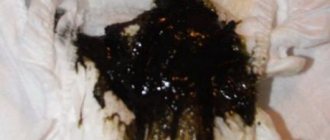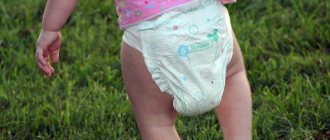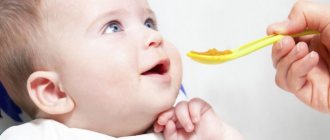Dirty and wet diapers do not surprise new parents - this is an element of life with a small child for which we are usually well prepared. But gradually moms and dads begin to worry about details: what kind of stool should a newborn have? How long should a newborn poop?
A newborn's stool can be liquid, hard, black, green, yellow - in general, all kinds of colors and consistencies. And the parents’ confusion here is quite understandable.
Changing a diaper is not only a hygiene ritual, but also a way to monitor the well-being and development of the baby.
From this article you will learn what the color, consistency and frequency of a baby's stool can indicate.
Normal stool in a baby
So, what kind of stool should a newborn have? The color and consistency of a small child's stool changes depending on various factors, especially what the baby eats.
Here's a quick look at what you might find in a diaper in the first few days, weeks, and months of your baby's life.
Meconium
The baby's first stool is meconium. It is a homogeneous tar-like mass of dark olive, almost black color and practically odorless.
This newborn's very first stool is made up of amniotic fluid, mucus, skin cells and other substances that the baby ingested while he was in the womb.
It will take several days before the meconium is completely cleared from the baby's body. Gradually, the baby's stool will acquire a yellow-green color (transitional), which will be replaced by yellow (mature stool). If your baby doesn't poop within the first 24 hours after birth, be sure to tell your doctor.
Mucus in a child's stool
Mucus in a child's stool does not always mean that something is wrong with the baby. The presence of mucus in a child’s stool is considered normal if there is little of it and there are no additional impurities. When mucus is found in excess, or its appearance is accompanied by other symptoms, this may be a sign of an intestinal infection. In this case, you need to consult a doctor. If the mucus contains blood stains, you should seek medical help immediately.
Normal stool in babies
A baby's regular stool may vary in color, consistency and smell depending on the baby's diet. Here are the possible options:
- Breastfed infants.
If you're breastfeeding, your baby's stools in the first few months may look a little like Dijon mustard, with a slightly runny consistency and possibly some white, seed-like flecks of fat. The color of a breastfeeding newborn's stool can also change depending on what the mother eats. For example, if you eat green vegetables such as spinach, your baby's stool may turn green.
- Formula-fed babies.
Babies who eat formula usually have less loose stools than babies on breastfeeding. The consistency of a formula-fed newborn's stool is paste-like and dark yellow or brown in color.
- Infants receiving complementary foods.
When your baby begins to try solid foods, which is usually around six months, you will notice (and smell!) significant changes in the contents of the diaper. The stool will become denser and more varied in color. If your baby eats kibble (finger food), you may see undigested pieces of food, such as pea skins or tomatoes, in the stool. This happens because your baby's digestive system is still learning to digest these new foods. With the introduction of complementary foods, the baby's stool also takes on a stronger odor due to the additional fats and sugar in his diet.
Diagnosis of causes
It is necessary to differentiate physiological manifestations of mucus from pathological ones. The main hint about the origin of the symptom is additional clinical manifestations and a thorough questioning of the mother (what the child ate, whether he was sick with anything recently, whether new complementary foods were introduced, whether there are hereditary diseases).
Basic tests that may be needed to identify the underlying cause:
- Coprogram. Microscopic and biochemical examination of feces will determine additional pathological signs: undigested food, the presence of hidden blood, worm eggs.
- Bacteriological culture (tank culture). Allows you to determine the presence of the pathogen and its sensitivity to antibacterial therapy.
- Culture for dysbiosis. Reveals the degree of separation of pathological and beneficial microflora.
- X-ray of the abdominal organs. Allows you to determine intestinal obstruction, an important test in infants with signs of abdominal bloating against the background of continuous crying (intussusception).
- Blood tests. Even a clinical analysis will make it possible to determine the nature of the inflammation (bacterial - with neutrophilic leukocytosis, viral - with lymphocytic leukocytosis, eosinophilia - with an autoimmune process or helminthic infestations). Blood tests are also carried out to check for antibodies and increased levels of autoimmune factors.
Green, gray, red - what does the color of the baby's stool mean?
You may be surprised by the variety of colors of a newborn's stool: mustard in breastfeeding babies, dark yellow or brownish in formula-fed babies, and various other shades of yellow, brown and even green.
Having discovered green stool in a baby, parents may worry, but, as a rule, in vain. Green stool in a baby can be the result of taking certain medications (by the baby or the mother if she is breastfeeding), green foods (which the baby eats or passes into breast milk) and more. So often green stool in a baby is simply the result of normal digestion.
All earthy tones are considered normal: from yellow to green and brown. But if you're concerned about the color of your newborn's or older baby's stool, don't hesitate to ask your doctor for advice!
When to worry
Stool of a certain color may be a sign of a health problem. Be sure to consult your pediatrician if your child's stool:
- Red.
The red color may be due to blood in the stool, so it is important for your doctor to determine the cause. But parents should know that there are many harmless reasons for red poop. For example, the baby may have swallowed a small amount of blood during childbirth. If a mother is breastfeeding and her nipples are cracked, blood may pass into the baby's breast milk. If your baby eats solid food, it may be because something like beetroot is staining his stool.
- Black.
In some cases, the stool may be black due to blood that may turn black in the stomach. It is important to note that sometimes dark green stool can be mistaken for black. And green stool in a child, even a dark shade, as a rule, is not a sign of anything dangerous. Meconium, a newborn's first stool, is also dark, almost black.
- White or grey.
Very rarely, the stool may be pale white or clay-colored. If this happens, see your doctor as soon as possible as this may be a sign of liver disease and treatment will be required.
YOU MAY ALSO LIKE
What's best for a child
Diarrhea in infants: causes of loose stools in a newborn
What does the color of mucus mean?
The color of the mucus indicates the nature of the process:
- Transparent slime. Most often it appears during viral inflammation, against the background of physiological causes.
- Green slime. Indicates the addition of a bacterial agent, or the passage of snot in transit through the entire gastrointestinal tract.
- White streaks of mucus. They talk about the presence of fibrin effusion and most often occur with fungal invasion (candidiasis, intestinal damage by Mycobacterium tuberculosis). Also, white streaks occur during helminthic infestation or during the healing of ulcers and erosions against the background of an autoimmune process.
- Streaks of blood. Appear when the capillary network is damaged or excessive permeability during intussusception or amoebic infection.
How often should a newborn poop?
How often your baby walks will vary as he grows and his digestive system develops. The type of feeding also affects the frequency of stool.
BEST PRODUCT
Pampers® Premium Care™ for Newborns
If you are breastfeeding
In general, if a baby is breastfeeding, he or she will likely pump more often than formula-fed babies. Two to five dirty diapers a day is the average frequency until your baby is about six weeks old.
Keep in mind that sometimes breastfeeding babies between three and six weeks of age may not poop for several days. This is because a baby's digestive system can digest breast milk very efficiently without leaving waste.
Once your baby is six weeks old, the frequency of bowel movements may decrease. One reason is that by this time, breast milk usually no longer contains colostrum, which can act as a laxative.
If your baby eats formula
If your baby is fed exclusively or primarily formula, he may start pooping at least once a day a few days after birth. That being said, it's okay if he doesn't poop for a day or two, as long as when he finally does, his stools are soft.
If at any time you are concerned about your baby's stool, consult your pediatrician.
Parents' actions
Having noticed unusual inclusions in the feces of their child, the first thing parents should do is to carefully look at his behavior: is he sleeping well, is he crying for no reason, is he behaving as usual or has something changed, has he lost his appetite... If everything is normal, and more mucus appeared, but there was no diarrhea, vomiting, or fever, you could exhale. Most likely, there was some kind of temporary glitch ⏱️.
In the same case, when there are accompanying symptoms and the stool contains characteristic impurities, you should not hesitate to visit a doctor. Without a diagnosis, there is no point in carrying out any treatment.
Consultation with a pediatrician, gastroenterologist (possibly a nutritionist, proctologist) and a high-quality examination are necessary.
Can a baby poop too much?
The amount of newborn stool may vary from time to time. If the child is gaining weight and the stool is soft, then most likely everything is fine.
If the stools are loose and very frequent (compared to the baby's normal range), or if the baby has other symptoms, such as a high temperature, it could be an intestinal infection.
If you suspect your baby has an infection, especially if he is under three months old, consult a doctor.
Keep in mind that newborns and infants often poop a little at a time, but several times in a row. Therefore, if the baby has just pooped, you can wait a little so as not to change the diaper again.
Treatment with medications
☝️ Mucus in the stool is not a disease, but one of the symptoms of some kind of deviation. There is an answer to the question, if a child has stool with mucus, what to do. It is not the effect that needs to be treated, but the cause. Drug therapy for different pathologies will differ. Eg:
- If a child has a cold, has caught an acute respiratory viral infection, bronchitis, or pneumonia, antiviral medications, nasal drops, gargles, and rubbing are prescribed.
- Dysbacteriosis is treated with intestinal antiseptics and probiotics.
- For infectious intestinal diseases, antibiotics and rehydration agents are indicated. Antiviral drugs may be prescribed.
- Thrush requires the use of antifungal drugs.
- Inflammatory bowel pathologies are treated with sulfalazines and glucocortiroids.
- Pancreatitis is fought with the help of enzyme-containing drugs.
- In the presence of erosions and ulcers, healing, relieving swelling, and painkillers are indicated.
Each case is individual. It is impossible to talk about a single tactic for combating mucus. Only a doctor selects therapy.
Constipation
Considering that the frequency of the baby's stool may vary, parents may be concerned about when the child is constipated. Most often, constipation occurs after the introduction of complementary foods, but they can also occur in newborns. Here are some typical signs of constipation:
- In a newborn
- hard stool.
- In an older child or toddler
- hard stools every three to four days.
- In infants and children of any age
- copious, hard and dry stools and painful sensations at the time of defecation; presence of blood in the stool. And also if the baby pushes to no avail for more than ten minutes.
What to do if you are constipated
If you think your baby is constipated, contact your doctor. Do not give your child any medications, including laxatives, unless prescribed by a doctor.
If there is no improvement or symptoms such as vomiting, fever, lethargy, loss of appetite, or blood in the stool occur, contact your doctor immediately.
Diet therapy
In order for intestinal function to recover faster, it is necessary to monitor the child’s nutrition. If the diarrhea is not severe and there are no signs of intoxication, in older children you need to reduce the amount of food by 15-20%. Food should be served pureed or mashed. From 3-5 days it is allowed to return to the previous diet. With moderate diarrhea, in the first days the amount of food is reduced by 20-30%, and over the course of 4-6 days they gradually return to the usual menu.
It is advisable not to consume foods that increase diarrhea. You should add foods containing soft fiber to your menu.
Diet for diarrhea with mucus in a child. Table 1
| Products to exclude | Recommended Products |
| sweets sweet drinks and juices concentrated meat broths; whole milk | tea porridges and cereal decoctions boiled vegetables baked apples |
How to tell if your baby has pooped
A baby's stool may not have a strong odor, especially in the first weeks of life. How do you know when it’s time for your baby to change his diaper?
You may notice your baby straining and his face turning red from exertion. Over time, you will understand by the expression on your baby's face that he is pooping. And when the baby begins to stand and takes his first steps, he will begin to squat when he is about to poop.
If you are not sure whether your baby has pooped, simply pull the diaper by the waistband and check without removing the diaper itself. If the diaper is the right size, the waistband will snap back into place when you release it. Find out more about how to choose the right diaper size.
The importance of stool control
Mucus in the feces of infants is not a pathological sign, so its appearance must be assessed in conjunction with other symptoms. If the child is active, has an excellent appetite, sleep corresponds to age standards, nothing threatens the baby’s health. If you have diarrhea, you should not self-medicate, especially experiment with probiotics. All medications must be prescribed by a pediatrician! In case of diarrhea, it is not recommended to limit the child’s feeding and wean him from the breast. Breast milk contains protective components that will speed up the healing process. It’s not for nothing that they say: “The baby’s health is in the mother’s milk.”
Traditional methods
In some cases, doctors advise not to forget about traditional medicine. With the help of herbal teas, tinctures of honey with black radish, coughs, runny nose, and colds are treated.
In the treatment of dysbacteriosis, decoctions of oak bark, chamomile, and cinquefoil have proven themselves to be effective. Honey, diluted with carrot juice, and garlic work well against worms. A tincture of chamomile flowers and dill seeds works well for indigestion and frequent constipation.
The presence of mucus in various disorders of the gastrointestinal tract
If a child poops with mucus, its presence can be observed due to various malfunctions of the gastrointestinal tract. The most common ones are:
- Diarrhea. In this case, the presence of mucus against the background of diarrhea can provoke dysbacteriosis. This especially often occurs during the treatment of various diseases with the help of medicinal substances that destroy the microflora of the child’s body. Taking antibiotics most often has a similar effect, not only disrupting the balance of microelements involved in the digestion of food, but also causing diarrhea.
- Constipation. This condition is one of the symptoms indicating malfunctions of the digestive system. In this case, the mucus may have either a transparent white color, indicating problems with the removal of hardened feces, or pale pink, which can occur due to mechanical destruction of the walls of the gastrointestinal tract.
In both cases, the appearance of mucus is a kind of reaction of the digestive organs, preventing their rapid destruction.











